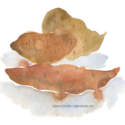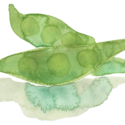Award Winning Author
Face Reading with Before & After Photos

Sweet Potatoes and Earth Element: Favor them Moist or Dry?
Some sweet potatoes cook up moist and others, relatively speaking, cook up dry. Here’s how to use Five Elements to discern which variety best suits your digestion. The so-called dry varieties (jewel, Japanese, and Hannah) are starchier and so more firm and mealy when cooked. The more “moist” garnets and Beauregards cook up softer and… Continue Reading







